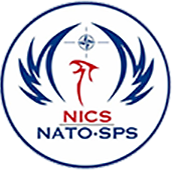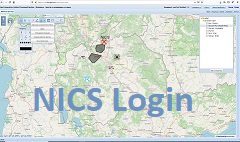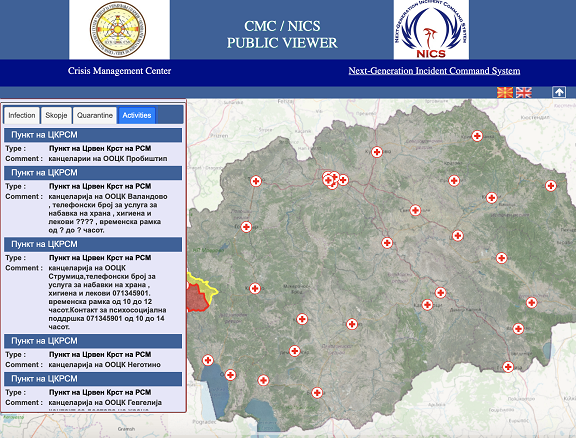When North Macedonia joined a project supported by the NATO Science for Peace and Security (SPS) Programme in 2016, the country teamed up with Lincoln Laboratory to adopt the Laboratory’s Next-Generation Incident Command System (NICS) as its official emergency-response platform. Now, this system is helping North Macedonian emergency agencies coordinate their national response to COVID-19.
NICS is a web-based communications and collaboration platform. Personnel sign onto the platform and add details about an emergency response on a shared incident map. On this map, users can draw boundaries, enable GPS-tracking of their own locations, send messages and reports to other responders, and add live videos and photos. Essentially, the platform is designed to be a centralized way to track all of the response activities during a large-scale emergency.
North Macedonia’s Crisis Management Center quickly adapted the platform to enhance its response to COVID-19. All emergency institutions in North Macedonia responsible for dealing with the pandemic are using NICS to coordinate, communicate, and cooperate countrywide. While normally only accessible to emergency personnel, NICS is also now being used for the first time to communicate directly with the public.
“North Macedonia is using the system as designed in that they are giving national, regional, and local authorities the tools to communicate and collaborate as needed. Yet, in addition to these core NICS capabilities, they are aggregating the data produced by the responding organizations into a ‘public room’ that can be shared in real time with the entire nation,” says Stephanie Foster, a technical staff member at Lincoln Laboratory who leads the NICS NATO program.
Lincoln Laboratory worked with the Crisis Management Center team to enable public access to NICS. The goals of enabling public access were to disseminate rapidly updating information about coronavirus cases and to inform citizens on where health resources are located. The public can access the NICS feed here, where information is displayed in four tabs.
In the first tab, “Infection,” the total number of infected people is displayed on the map, including the numbers of those who have recovered and those who are deceased. These data can be shown countrywide or drilled down to specific municipalities, as shown in the second tab, labeled “Skopje,” the capital city of North Macedonia.
In the third tab, “Quarantine,” the total number of isolated people is displayed, including those who are self-isolating and those who are under supervision. The last tab, “Activities,” shows the locations of health resources for the public along with contact information. “The Red Cross is very active in NICS. The markers on the public map show Red Cross locations. If you click on them, you can get details such as the address and resources,” Foster says.
NICS was originally developed a decade ago by Lincoln Laboratory and the Department of Homeland Security Science and Technology Directorate (DHS S&T) to help California coordinate their responses to wildfires. Since then, responders across 250 organizations worldwide have been trained to use it. The adoption of NICS in North Macedonia is part of a wider NATO SPS project, called the Advanced Regional Civil Emergency Coordination Pilot, which aims to enhance the emergency collaboration among and within the Southeastern European nations of Bosnia and Herzegovina, Croatia, Montenegro, and North Macedonia.
“We are very pleased to see a DHS S&T–funded technology, which was originally intended to help U.S. firefighters, is successfully scaled to support real-world events in North Macedonia. As a result of our collaboration with NATO SPS and Lincoln Laboratory, NICS is not only used in North Macedonia but also in other Western Balkan countries in their day-to-day operations,” says Ron Langhelm, NICS project manager at DHS S&T.
Eyup Turmus, SPS Advisor and Programme Manager at NATO, adds that the “SPS project enhanced the capacity of North Macedonia to deal with the coronavirus crisis as the country formally became the 30th member of NATO on March 27, 2020.”
Foster thinks that NICS could help support COVID-19 coordination in other places where the system is available. “NICS is the perfect platform for aggregating data and sharing real-time status across several different organizations. It was designed to interoperate with other systems and datasets — not to replace current systems, but to bring a higher level of visibility and awareness to resource availability, location information, et cetera. The possibilities are endless.”


